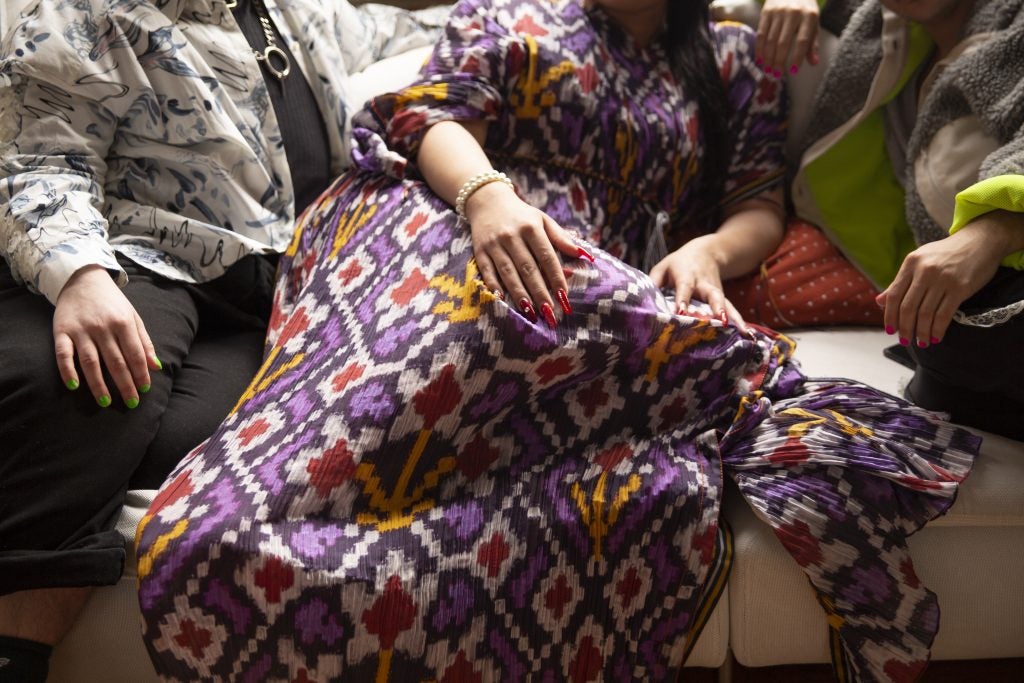Table of Contents
Fetishistic Transvestism

Transvestism, most commonly referred to as “cross-dressing,” refers to the act of experiencing sexual arousal from wearing clothes typically associated with the opposite gender. For example, a Transvestism, more commonly known as “cross-dressing,” refers to the act of experiencing sexual arousal from wearing clothes typically associated with wearing cloths associated with a gender different from one’s own. For example, an individual who identifies as male may become sexually aroused by wearing a bra and skirt while an individual who identifies as a woman may become aroused by wearing a jockstrap. Cross-dressing is typically a brief, private activity. People who cross-dress typically do so in private, and when someone does cross-dress in public, they tend to characterize such behavior as going out “in drag”.1
General cross-dressing is different from transvestic fetishism. Transvestic fetishism is when cross-dressing becomes a person’s only source of arousal. Transvestism is also different from identifying as transgender, which is when individuals feel that their sexual anatomy does not match their gender identity. Transgender people dress according to their gender identity rather than wearing clothing associated with their sex assigned at birth; however, unlike cross-dressing and going out in drag, transgender individuals choose their clothing in conjunction with other gender-affirming life-style choices. In fact, many cross-dressers identify as cisgender and heterosexual. Therefore, cross-dressing is not necessarily a homosexual act and is not indicative of a person’s gender identity.2
Subcategories of Transvestism
Cross-dressers may not have a more specific label for themselves, or may choose not to label themselves at all; however, some cross-dressers identify with one of three common subgroups: nuclear transvestism, marginal transvestism, and fetishistic transsexualism.2, 3

“Nuclear transvestism” is defined by people who cross-dress, but make no bodily changes to feminize or masculinize themselves. “Marginal” cross-dressers choose to cross-dress, but also desire or have bodily alterations to become more like another gender, such as implants or hormone therapy. The third category, “fetishistic transsexualism,” is similar to being transgender, however, a person in this group is sexually aroused by seeing themself as another gender in addition to identifying as the gender. Note that nuclear transvestism is far more common than marginal transvestism and fetishistic transsexualism.3
Reasons for Cross-Dressing
Transvestism can be appealing for several different reasons. Some cross-dressers enjoy the feeling of violating a taboo that is associated with wearing the clothing that may be worn by another gender. Some people view cross-dressing as a fun version of role-playing. Others may enjoy escaping the gender roles imposed on them by society. Still, others cross-dress out of curiosity of knowing what it is like to be the opposite gender than what they identify as. There can be an unlimited amount of other reasons why people might choose to wear another gender’s clothing.1, 2
People who identify as male are more likely than those who identify as female to cross-dress for sexual arousal. In general, people who identify as male are more likely to have sexual fetishes because, on average, they have more erotic sexual experiences when they are younger than those who identify as female.1 These provide more opportunities for male-identifying individuals to be conditioned and learn what arouses them sexually. This means they are more likely to respond to visual images and tactile stimuli (such as wearing feminine clothing) in a sexual way. Male identifying individuals also have more practical opportunities to cross-dress because there are many more garments exclusively labeled female, such as skirts, thong underwear, dresses, bras, high heels, etc. Woman identifying individuals seem to cross-dress less frequently than male identifying individuals. Sociologists argue that this can either take away the thrill of cross-dressing or make cross-dressing less noticeable.1
Individuals vary in the extent to which they cross-dress. Some individuals who identifies as male may try on their female partner’s skirt or bra once or twice for fun and would not label themselves as cross-dressers. Some male identifying individuals regularly incorporate wearing another gender’s clothing into masturbation or sexual activity. Frequent cross-dressers may have a different name for their alter-gendered ego.1 Some cross-dressers even take hormone treatments or get breast implants to make their bodies look more feminine for when they are dressing up, although this occurs infrequently and can be considered a more extreme form of cross-dressing.2 Cross-dressers that alter their bodies may not consider themselves to be transgender d nor want to live as a different gender, and may simply enjoy certain aspects of a gender with which they do not identify. Individuals who cross-dress do not typically feel trapped in the wrong body and often identify with the sex they were assigned at birth.2
Many people with penises who cross-dress can be scientifically deemed to fit the category of having an autogynephilia, a paraphilic tendency in male identifying individuals who are sexually aroused by the thought or perception of being a different gender than what they identify themselves as.4 The root causes and instincts that may entice this paraphilia are hard to quantify in scientific studies as it can be inwardly defined, varying from person to person as the arousal of many men correlates to their erotic interests. However, when observing the responses of men to external stimuli, there was a strong association between autogynephilia and gyandromorphophilia, which is the sexual attraction to gynandromorphs (individuals with both male and female characteristics). In the study, the sexual arousal of autogynephilic individuals who identified as male were compared to that of gyandromorphophilic individuals who identified as male, heterosexual individuals who identified as male, and homosexual individuals who identified as male. Results indicated a strong resemblance between the arousal of the autogynephilic, gyandromorphophilic, and heterosexual groups.2, 4 The study showed the male identifying people from each group explicit videos of other male and female identifying individuals and gynandromorphs.4 Autogynephilic individuals experienced increased arousal by gyandromorphs, rather than the heterosexual male identifying individuals who were more aroused by the stimuli involving female identifying individuals. Results from the external stimuli experiment indicate that many individuals who identify as male who cross-dress share similar sexual patterns as gyandromorphophilic male identifying individuals.4 While it may be harder to understand the exact reason behind why this stimulation is experienced, scientists have been able to quantify and acknowledge its existence in a lab setting, suggesting that the psychological and physiological response is very much present.4
While cross-dressing is a conscious act of choosing to put certain articles of clothing on, there are physiological reasons and responses that can help support the claim that the desire to want to cross-dress is not always a choice.2 Individuals who may not consider themselves to be autogynephilic may still have overlapping sexual patterns that can be quantified in a scientific setting,4 and while cross-dressing may feel as a choice to many who do so, it comes with an expression of self-identity and should consequently not be discouraged.

It is important to note that many individuals may not cross-dress as a paraphilia. Many cross-dressers have transvestism which is defined to be a fetish–and a fetish is a type of paraphilia. Further, cross-dressing should not be confused with severe gender dysphoria, which is a separate condition that usually occurs when a transgender or non-binary person experiences extreme discomfort in connection with the gendered expectations imposed upon them according to their sex assigned at birth.2 Such intense gender dysphoria rarely affects individuals who cross-dress, but occasionally, cross-dressers may also report feelings of gender dysphoria. Often, many heterosexual individuals who cross-dress begin to do so in later childhood, and the act is typically initially affiliated with sexual arousal. However, sexual arousal is not the reason for cross-dressing, as many individuals may feel more like themselves when doing so. To elaborate, cross-dressing may provide a sense of experimentation and fun, could be relaxing, and could even reduce anxiety.5 During an additional study of males with transvestism, results stated that these individuals frequently reported feeling relaxed, comfortable, and relieved of societally defined masculine demands. These results reiterate the presence of self-identity when cross-dressing takes place and the mental ease that many may experience from fulfilling their desires to cross-dress.4 Thus, it can be concluded that mental satisfaction is a common and significant drive in the desire to cross-dress.6
Transvestic Disorder
It is important to recognize a core contributor to the stigma surrounding cross-dressing, as many individuals may try to invalidate those who cross-dress by labeling them to be ill or suffering from a disorder. While there is still endless research that can be conducted and completed to better understand the psychological and physiological desire to cross-dress, labeling those who do so as “disordered” can create a dangerous precedent. Many behaviors or desires that diverge from heteronormative standards can be mislabeled and stigmatized, as it goes against typical societal values. There is significant stigma that surrounds non-heterosexual sexual orientations along with the presence of stigma regarding individuals who may not fit into heterotypical or cisgender standards. Oftentimes, anything that contrasts with what is societally accepted to be “normal” comes with immense stigma, and unfortunately, the inclusion of medical terms with these societally atypical tendencies can further motivate unacceptance. This phenomenon can be seen in the HIV/AIDS pandemic where the gay community faced many crimes and was negatively labeled due to the prevalence of the virus in many homosexual communities. Further, while transvestic disorder is an existing condition, the presence of the term can encourage individuals to invalidate or devalue cross-dressing as a legitimate expression of identity or a simple act of fun.4
While some medical professionals may label transvestism to be a transvestic disorder, the term typically comes with many conditions that many people are not aware of. Transvestic disorders are medically valid and labeled in the Diagnostic and Statistical Manual of Mental Disorders (DSM-5): a book used by mental health professionals, consisting of standard classifications of mental disorders.8 Although the transvestism disorder is recognized in the DSM-5, the term does not pertain to all individuals who cross-dress. Rather, a transvestic disorder can be better defined as a condition where an individual feels intense sexual arousal when wearing clothes/accessories that they affiliate with the opposite gender.8 These feelings come with immense distress in the individual’s life and often interfere with the comfort and quality of life.7, 8 The DSM-5 definition for transvestic disorder contrasts with transvestism, as typically individuals who are cross-dressers feel happier when they cross-dress. The premise of labeling this form of cross-dressing as a disorder is when it causes severe disturbance in one’s life. In fact, transvestic disorder diagnosis is considered to be very rare, as the American Psychiatric Association found in 2013 that less than 3% of men found sexual arousal from cross-dressing.7 However, treatment options are still being properly researched and analyzed as there is no cure for transvestism, rather “treatments” focus more on accepting cross-dressing as a form of identity and consequently learning and validating self-acceptance which can alleviate stress in one’s life.8
Drag

People who participate in drag vary in their reasoning for dressing up as another gender. Generally, drag queens have an internal sense of being male that does not change when performing in drag, while some see their performances as an outlet for a feminine portion of their gender identity.9 Many drag queens report feelings of arousal while performing in drag, but this is more rooted in a flirtatious energy with the audience than it is a direct result of cross-dressing alone. Many see it as an artistic outlet above all else, but some also see drag as a way to explore their identity.9
Fears and Treatment
It can be very difficult for a cross-dresser to open up to a partner or friend and explain their sexual activity.1 Many cross-dressers are happily married or partnered to people who understand and accept their behaviors, but for others, the fear of judgement can lead them to hide this part of themselves, or even try to change it.2 Some cross-dressers feel guilty and uncomfortable for their behavior and may try and seek treatment to “cure” themselves.1, 2
Commonly, this occurs when the individual’s partner is not supportive or cooperative of their cross-dressing. These can lead to feelings of guilt, depression, shame, and anxiety about their inherent yearning to cross-dress. As a form of self-treatment, many of these individuals may completely remove any articles of clothing or accessories that they associate with cross-dressing as an attempt to eliminate their desire to cross-dress. However, this method is often unsuccessful and can result in repurchasing discarded materials which can reestablish intensified feelings of guilt and shame.6
Those who seek treatment for their cross-dressing behaviors are usually ashamed of their desires. Treatment history shows, however, that trying to eliminate cross-dressing is almost always unsuccessful and leaves the patient feeling isolated.2 Recent studies find that the best method of treatment involves approaching the patient’s cross-dressing behavior without judgement and encouraging them to embrace that part of themselves.10 A key aspect of this technique is to compromise the desire to cross-dress with social restrictions. As an example, a person may be advised to cross-dress in their home or at a club, but not at a job interview.10

An important part of supporting someone having a hard time coming to terms with their desire to cross-dress is to remind them that cross-dressing is not abnormal. A more considerate approach is making the distinction between what is “normal” and what is “conventional.” Therefore, a cross-dresser is a normal person with an unconventional habit.1, 10 This line of thinking prevents dehumanization of people like cross-dressers, whose behavior falls outside of social expectations.
There are numerous support groups designed to help cross-dressers, their partners, and sometimes their families. These groups can create a sense of community and unity for cross-dressers as well as foster an attitude of understanding and acceptance.7 Unless transvestism causes serious distress or danger in an individual’s life, it typically does not require any treatment. Social and support groups can help establish a sense of community and validate an individual that it is okay to cross-dress. Oftentimes, if an individual seeks psychotherapy, the sessions will be spent encouraging acceptance and learning to control any behaviors that may cause harm to oneself or others–rather than attempting to cure transvestism.7 A primary motivator for this is that research has found that transvestism is commonly not harmful or perceived as a disorder in the medical community. Further, no drugs have been found to be reliably effective when attempting to treat transvestism. Thus, it is crucial that individuals who find joy in cross-dressing can do so in a safe and comfortable manner, where they can feel accepted.7, 8
Concluding Remarks

Transvestism is a broad category, and the line between gender expression and means of arousal is often blurred, if such distinction is made at all. No matter the reason, cross-dressing can be a way to explore one’s sense of self and expand the social restrictions put on identity. With greater representation of unconventional gender expression in recent years, conversations about transvestism, fetishistic or otherwise, are likely to become more understood and accepted simply as a different way of expressing oneself.
References
- Bloom, Amy. “Normal : transsexual CEOs, cross-dressing cops, and hermaphrodites with attitude.” Ed. 1. Random House: New York, 2002.
- Docter, R. F., & Prince, V. (1997). Transvestism: A survey of 1032 cross-dressers. Archives of Sexual Behavior, 26(6), 589-605.
- Buhrich, Neil. McConaghy, Neil. “Three Clinically Discrete Categories of Fetishistic Transvestism.” 01 March 1979. Vol. 8, no. 2.
- Hsu, Kevin J. Rosenthal, A. M. Miller, David I. Bailey, Michael J. “Sexual Arousal Patterns of Autogynephilic Male Cross-Dressers”. Archives of Sexual Behavior. Vol. 46. 12 Sept. 2016. P. 247-253.
- Brown, George R. “Transvestism” Merck Manual: Consumer version. April 2021.
- Buhrich N. “Motivation for cross-dressing in heterosexual transvestism” Acta Psychiatric Scand. Vol. 57. Feb 1978. P. 145-152.
- Diagnostic and statistical manual of mental disorders (5th ed.). American Psychiatric Association (2013). P. 702-705.
- Fedoroff, Paul J. “Transvestic Disorder”. Oxford Medicine. 2019 Oct.
- Levitt, Heidi M. Surace, Francisco I. Wheeler, Emily E. Maki, Erik. Alcantara, Darcy. Cadet, Melanie. Cullipher, Steven. Desai, Sheila. Sada, Gabriel Garza. Hite, John. Kosterina, Elena. Krill, Sarah. Lui, Charles. Manove, Emily. Martin, Ryan J. Ngai, Courtney. “Drag Gender: Experiences of Gender for Gay and Queer Men who Perform Drag.” Sex Roles. Vol. 78. No. 5. 01 March 2018. P. 367-384.
- Gallo, Mona. “Treating Transvestism: A Counselor’s Look at Diagnosing and Treatment of Cross-Dressers.” April 2016. The Family Journal. p. 195-199.
Last Updated: 24 May 2022.
